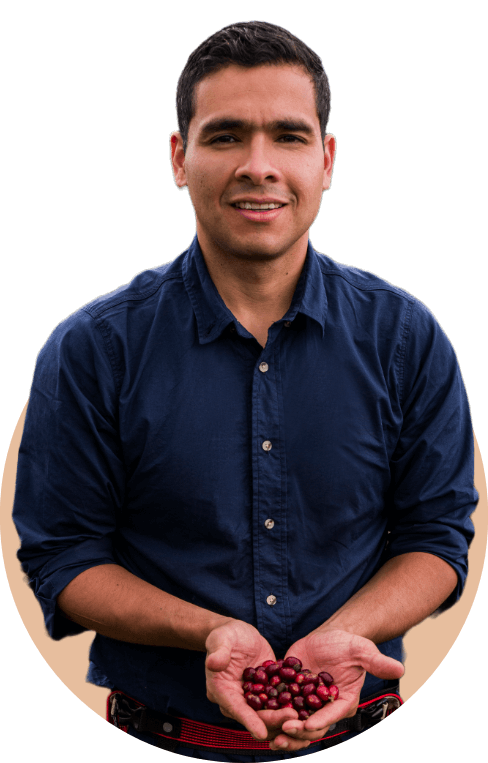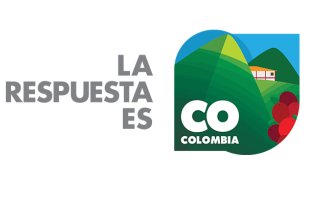RECOLECTANDO HISTORIAS DE CAFÉ
MÁS QUE UN GRANO O UNA BEBIDA, EL CAFÉ ES PARTE DE NUESTRA ESENCIA.
El café es un estilo de vida para cientos de miles de familias campesinas. Lo siembran caficultores de montaña, de sonrisa amable y pujanza admirable. Lo siembran distintos pueblos indígenas en un gesto de respeto y comunión con la naturaleza. Lo siembran empresarios del campo, líderes en innovación y nuevas técnicas. Lo sembramos todos, distintos y al tiempo similares: colombianos orgullosos de nuestra historia y sabor.
En una taza no bebes solo café de Colombia: bebes un poco de nuestra calidez, de nuestros matices y diversidad. Bebes un poco de lo que somos: alegría, elegancia, diferencia, suavidad. El sabor, el aroma, las notas, todo junto hace de esta una bebida que invita a vivir encuentros, bienvenidas y momentos inolvidables.

DIEGO CAMPOS
The world’s best barista is Colombian
Behind every cup of coffee lies a story, and that of Diego Campos is a remarkable one. What our talented barista from Tolima has achieved is immense: Diego conquered HostMilano 2021, competing with Colombian coffee roasted at origin, and earning the title of best barista in the world.
What began for him as a family passion is now a global milestone. Crafted by the hands of Diego Campos come some of the best cups of Colombian coffee you’ll ever taste, rich in textures, aromas, profiles and preparations. Thanks to him and his enduring passion for our coffee traditions, we no longer just produce the best coffee in the world—we also prepare it.
COFFEE IS BORN HERE
23 of Colombia's 32 departments grow different types of coffee. The 5 largest producers are the following: Huila, with 17% of overall national production; followed by Antioquia, with 13%; Tolima, with 12%; Cauca, which contributes 11%; and Caldas, with 7%.
There are currently around 900,000 hectares dedicated to coffee farming. We grow coffee from 800 to 2,200 meters above sea level, but most of our crops are located between 1,200 and 1,800 meters above sea level.
MANUFACTURE AND PROCESSING
We are one of the few countries in the world that grow coffee year-round. Harvests can be found all over our territory.
Coffee grown in the north has a high body with low acidity and an aroma heightened by chocolate notes; the central areas produce coffee of medium body and acidity with a high variety of fruity and herbal aromas; whereas in the south you can find coffee with a medium to high acidity, a medium body and distinct floral and sweet notes.
FROM BEAN TO CUP
In Colombia, we have washed mild arabica coffees, which means the following: coffee farmers hand pick the ripe cherries one by one—these contain the sugars and nutrients that are impregnated in the bean and generate the great variety of aromas and flavors.
Once we have the fruit (the red cherry), the "beneficio" is carried out. In Colombia, this is made by washing. After this, we have the parchment coffee, which is then dried by hand in the sunlight.
Year-long harvest
¿Did you know that coffee is grown in Colombia all 365 days of the year? Our coffee is washed mild arabica, which means our farmers hand-pick ripe fruits one by one, selecting beans that have been impregnated by the sugars and nutrients generate a wide variety of aromas and flavors.

Our most precious secret
Did you know that Colombia harvests the 6 best varieties of Arabic coffee in the world? These are: Typical, Bourbon, Maragogipe, Tabi, Caturra, and Castillo Variety.

More than "Colombian coffee"
We don't produce just one coffee variety. The diversity of our soil allows for multiple flavors and unique aromas. Colombia produces 6 designation of origin coffees, recognized internationally for their superb quality: Cauca, Nariño, Huila, Santander, Tolima and Sierra Nevada

Coffee roasted at origin
The Colombian coffee roasted at origin allows us to provide a complete experience, from the seed to the cup, offering the quality and warmth that we are used to produce and prepare coffee in Colombia.

From our hands to the world
Coffee in Colombia is dried in the sunlight. This is one of the keys to achieve that artisanal touch that renders it so unique and guarantees a more homogeneous product. It also ensures that the coffee retains all of its characteristics.

The beauty behind each cup
Coffee is grown in 23 of Colombia's 32 departments. This reflects the beauty of Colombian culture, traditions and people. Every Colombian home will always welcome you with a smile and a cup of coffee.

What renders colombian coffee so unique?
Click on the icons and find out the 6 reasons
![]()
The beauty behind each cup
Coffee is grown in 23 of Colombia's 32 departments. This reflects the beauty of Colombian culture, traditions and people. Every Colombian home will always welcome you with a smile and a cup of coffee.
From our hands to the world
Coffee in Colombia is dried in the sunlight. This is one of the keys to achieve that artisanal touch that renders it so unique and guarantees a more homogeneous product. It also ensures that the coffee retains all of its characteristics.
Coffee roasted at origin
The Colombian coffee roasted at origin allows us to provide a complete experience, from the seed to the cup, offering the quality and warmth that we are used to produce and prepare coffee in Colombia.
More than "Colombian coffee"
We don't produce just one coffee variety. The diversity of our soil allows for multiple flavors and unique aromas. Colombia produces 6 designation of origin coffees, recognized internationally for their superb quality: Cauca, Nariño, Huila, Santander, Tolima and Sierra Nevada
Our most precious secret
Did you know that Colombia harvests the 6 best varieties of Arabic coffee in the world? These are: Typical, Bourbon, Maragogipe, Tabi, Caturra, and Castillo Variety.
Year-long harvest
¿Did you know that coffee is grown in Colombia all 365 days of the year? Our coffee is washed mild arabica, which means our farmers hand-pick ripe fruits one by one, selecting beans that have been impregnated by the sugars and nutrients generate a wide variety of aromas and flavors.
 Welcome, you are in
Welcome, you are in 









